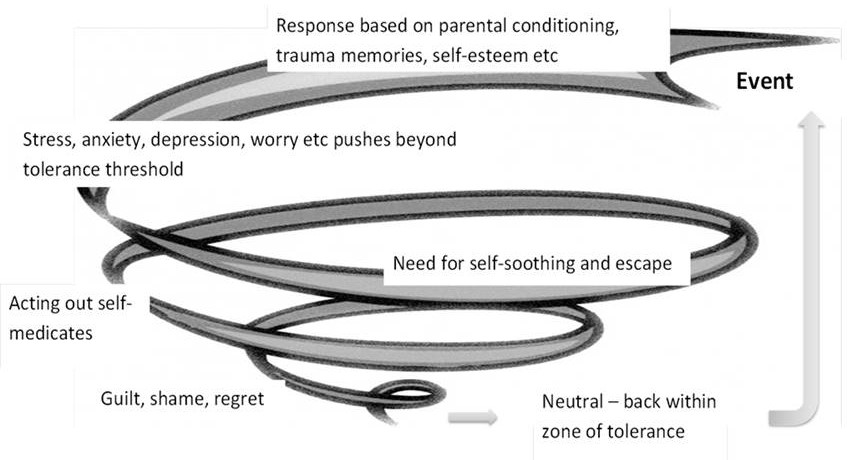Free Resources for Sex and Porn Addiction – Module 2

Free Resources for Sex and Porn Addiction - Module 2
Figure 1: Behavioural Spiral of Sexual Addiction
Your type 1 behavioural level pattern is driven by unpleasant and intolerable thoughts and emotions in response to difficult and challenging experiences. Problematic events (such as being ditched by a long-term partner or work-related stress) generate an intolerable response (anger, sadness, rejection, helplessness etc.) which in turn creates a need for self-soothing and escape. Sex and porn addiction are dysfunctional forms of self-soothing and escape from problems contrasted with, for example, sharing things with a friend or professional helper. For examples of triggering experiences see other blogs

Shift to Neutral and Stay in Neutral
Reasons To Be Addicted – 3 Key Areas

Conditioning
how you have been ‘programmed’ by your upbringing governs how you respond in any given situation (in the above example you have been conditioned to be fearful of a figurehead as a means of discipline). Another way to see these is as your ‘set-up’ as someone who is likely, if triggered, to turn to some form of acting out as a coping mechanism.

Crunch points
these are events in your life that have been defining triggers for becoming dependent on sex and/or porn and maybe other forms of compulsive behaviours. Examples include unavoidable events such as parental divorce or death of a parent during your childhood or avoidable events like negligently losing a job due or choosing to commit to a relationship despite warning signs.

Chronic factors
these are aspects of your life that are either always present or persistently re-surfacing. They usually arise from consequences arising from past choices or a failure to make changes to the conditioning above. These factors perpetuate and maintain the fertile context for addictive behaviours. Examples include having financial problems due to poor discipline around money or always allowing anger to dominate and destroy your relationships.
Self-assessment
Relating to others
- You often experience noticeable anxiety, mistrust or jealousy when not with a partner.
- You constantly seek reassurance of others’/partners’ love and availability for you.
- You often find that others are not very good at providing comfort and satisfaction in the relationship.
- You tend to strongly avoid intimacy and closeness.
- You are extremely anxious about being rejected/hurt/betrayed but at the same time really want close relationships.
- You find it often takes a long time to get into close relationships.
- You are more likely to avoid intimacy/closeness than welcome it.
- You are usually content being self-sufficient, often compulsively so.
- You generally do not seek emotional closeness and physical affection.
Traumatic events
- Physical, emotional or sexual abuse (over time or certain incidents)
- Witnessing domestic violence
- Parental death or divorce when you were young
- Sibling death, injury or serious health issues
- Involvement in serious, life-threatening accidents/incidents
- Witnessing serious, life-threatening accidents/incidents
- Serious injuries, surgery and health issues (including pre and during birth)
- Extended separation from parents as an infant/child (adopted, fostered, child-minded etc.)
- Being bullied by siblings, relatives, peers, teachers, managers.
- Being attacked/sexually assaulted/raped or threatened by such.
- Own difficult relationships, break-ups or divorce
- Death, injury, disability and illnesses of a partner, child (including miscarriage)
- Difficulties in starting a family, fertility processes etc.
- Redundancy and other serious career setbacks
- Major setback such as business failure, loss of home/security
Personality related
- Never feeling loved/cared for
- Fear of being on your own/abandoned
- Being suspicious of others’ motives, generally mistrusting of others
- Feeling different to everyone else and alienated
- Having a sense that you are not good enough and flawed
- Sense of having failed in life and/or work
- Feeling that you can’t cope with life
- Having worries that the worst is always about to happen; pessimism.
- Always seem to be caring for others at your own expense
- Hiding emotions
- Perfectionism
- Being impulsive and lacking commitment
Your results
Relating to others = if you tick 2 or more out of each of the blocks of 1-3, 4-6 or 7-9 you are indicating possible insecurities when it comes to relationships. These might mean that relationships are a source of constant challenge, difficulty or stress for you and you should target your resources to addressing this aspect of your life. Early years are usually at the roots of such difficulties.
Traumatic events = experiencing any of these can mean a potential lasting negative effect on your life especially if the experience was not mediated at the time i.e. through counselling. Experiencing several of these events might have a multiplying impact on your emotional and psychological health. Some form of therapy such as EMDR is recommended.
Personality-related = any medium or high scores indicate aspects of your outlook on life or your self-perception may be constant sources of out-of-control responses to events and situations and could be contributing to your need for addictive behaviours. Working through a self-help book such as Reinventing Your Life by Jeffrey Young or seeking professional coaching or counselling is essential in this case.
